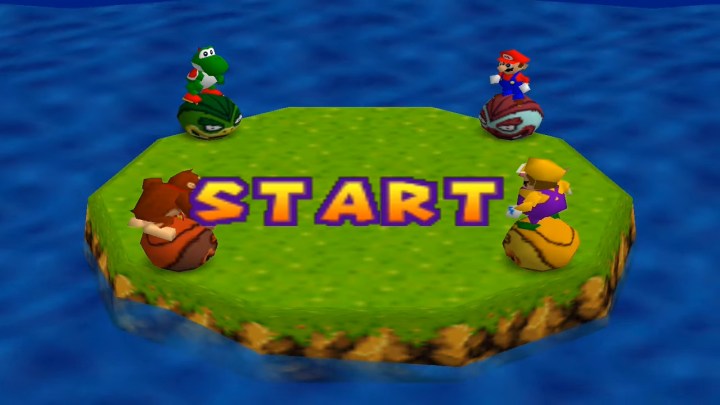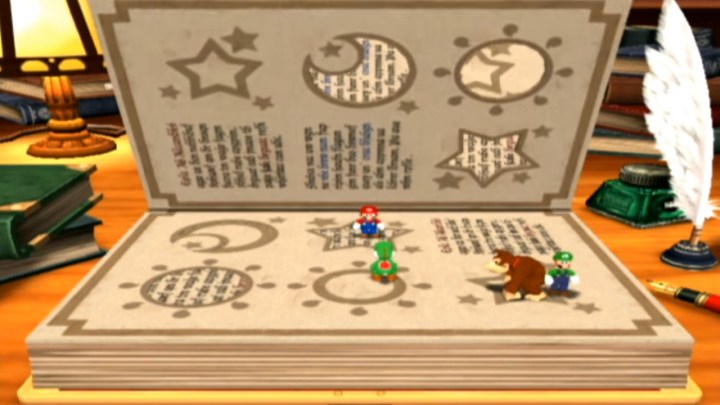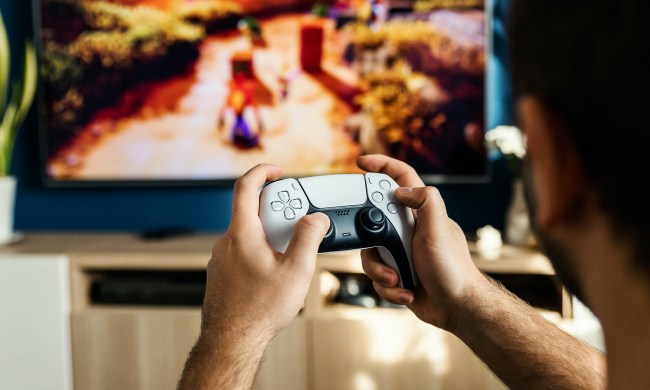Clearly inspired by traditional board games, the Mario Party series has always melded what people love about those classic physical games with the advantages that could only be done in video games. The basic rules are always simple to grasp: Roll a die to move around the board, get enough currency (coins in nearly all the games) to purchase a star, and whoever has the most stars at the end wins. There’s plenty of twists and tweaks to keep things interesting there, but the very heart of the game is absolutely the mini-games. After every player moves, there is a mini-game break where the winner, or sometimes multiple winners, can earn extra coins.
- Face Lift (Mario Party)
- Bumper Balls (Mario Party 2)
- Mushroom Mix-Up (Mario Party 1)
- Booksquirm (Mario Party 4)
- Snow Brawl (Mario Party 6)
- Sneak ‘n’ Snore (Mario Party 2)
- Crazy Cutter (Mario Party)
- Tumble Temple (Mario Party 9)
- Hotel Goomba (Mario Party 5)
- Look Away (Mario Party 2)
- Slaparazzi (Super Mario Party)
- Bowser’s Big Blast (Mario Party 2)
- Dash and Dine (Super Mario Party)
- Bob-Omb Bogey (Mario Party 10)
With more than 10 Mario Party games out now, there have been well over 100 mini-games included in the series. Between free-for-alls, 2v2s, 3v1s, and rarer special event games, there is a huge range in what each game asks of the player. Some have stood the test of time better than others (we’re looking at you, Mario Party’s Tog o’ War), so we’ve looked back across the entire franchise to make our list of the best Mario Party mini-games of all time.
Some mini-games appear in multiple games, sometimes with different themes or names, so in those cases, we’ll be listing them in the game they first appeared in.
Further reading
- Mario Party Superstars review: The do-over fans deserve
- The best Mario Party games, ranked from best to worst
- The best multiplayer games on Nintendo Switch
Face Lift (Mario Party)

This is a personal favorite of ours, and is basically a play on the little tech demo thing at the beginning of Mario 64 where you can tug on different parts of a giant Mario face. This showed up first in the original Mario Party as a regular mini-game, then returned in the sequel as a much less common Battle mini-game. The game will open with Bowser’s face becoming stretched and warped in various ways, and each player will then have a default Bowser face they need to pinch and pull on to best match the one the game presents. In Mario Party 2, the roster of faces is expanded to include every playable character, such as Mario, Luigi, and Yoshi. When the time runs out, every player’s face is graded on a scale of 0 to 100, and whoever made their face closest is the winner.
What makes this so much fun is the combination of playing with these iconic characters’ faces in funny ways with the weird level of focus and precision you will want to commit. You’ll want to make Donkey Kong’s upper lip and brow look just right, but the timer forces you to balance matching one aspect perfectly at the risk of not getting to the ears or nose. There’s no luck, random elements, or anything like that, and yet it’s also unlikely any one person’s skill will make it less fun or unfair to the others. It’s everything great about a Mario Party mini-game wrapped up in a funny face.
Bumper Balls (Mario Party 2)

One trend we’ll keep coming back to on this list is that a lot of the best mini-games this series has seen are also the most simple in concept. Case in point, Bumper Balls from Mario Party 2. The setup is simple: You are each placed on a small island standing on inflatable balls with the goal of bumping into one another to try and knock them off the stage. You can move and build up more momentum, but otherwise, this is all about strategy. There are no gimmicks or finicky controls, either. Just you, three opponents, and one minute to try and be the last one standing.
Despite being a free-for-all mini-game, Bumper Balls often sees alliances formed and broken in record time. If one person teeters too close to the edge, the others will often gang up to try to confirm the kill, but whoever attacks first will be the most in danger next, leading to plenty of mind games. Do you want to avoid the pack, ram anyone who comes near you, or maybe try and bait someone into hitting you near the edge and try to dodge them so they end up rolling themselves off? Any and all of these tactics can work, making this simple game of rolling around big bouncy balls one of the all-time greats.
Mushroom Mix-Up (Mario Party 1)

Mushroom Mix-Up, which became Hexagon Heat in Mario Party 2, perfectly captures that sense of tension and chaos that we all love in Mario Party mini-games. The idea is that all four players are placed in the middle of a hexagon of different-colored platforms, mushrooms in the first game and generic metal hexagons in the sequel. A toad stands on his own platform and will show everyone a flag identical to one of the colored spaces. Every other platform will lower down into the water, or lava, eliminating them from the game. As the game goes on, the amount of time you have to get onto the correct platform gets shorter and shorter until only one player remains.
Recognizing the safe space you need to reach is only part of what raises the tension on this particular mini-game. Once you know where you have to go and recognize where that space is, actually getting on is half the trouble. Four characters can barely all squeeze on at once, and blocking others from getting on is absolutely a strategy, but can also just happen accidentally. You can’t attack during this game, but you can jump. That may help when things speed up and you need to try and save yourself from falling into the water or lava, but jumping also means you might land on top of another player’s head, bouncing you off in who knows what direction. You might manage to steer your bounce and survive, or end up sailing off in a fit of laughter. Either way, this is one we all look forward to showing up in the rotation.
Booksquirm (Mario Party 4)

When you look at them back to back, Booksquirm is actually very similar to Mushroom Mix-Up. They both center around the idea of figuring out where the safe place to stand is and getting there fast enough, and without getting blocked by other players. In Booksquirm, you’re not racing to a platform to avoid getting dropped, but almost the opposite. You are shrunk down and placed on the pages of a book. As pages fall, threatening to squish you, you will see certain shapes cut out of the falling page that you need to align yourself with to slip through. Again, the longer the round lasts, the faster the pages will flip.
This time you won’t have a Toad telling you where you need to go, but need to use your spatial awareness and shadows to figure out where to stand. There are technically only six places a safe space could be, and early on there can be more than one, but thanks to the different shapes, like the devious crescent moon, you can still get eliminated if you don’t line yourself up correctly. You can see in advance where the next safe areas will be by looking at the upcoming page and relating the cut-out spot to where it will be once it falls, which is a fun bit of brainwork that isn’t overly taxing. You can also use the shadows, but once things get speedy, you probably won’t have time to move where you need to.
Snow Brawl (Mario Party 6)

1 vs. 3 mini-games are the hardest to get right. Too often they’re unbalanced in one team’s favor, with either the single person being overly powerful or the three too easily overwhelming the one. When it works, though, they’re some of the most different and fun games in the series. Snow Brawl takes the already fun concept of a snowball fight and puts the Mario Party twist on it. This would be such an easy game to slot into a 2 vs. 2 type game, but they decided to push themselves and make it a 1 on 3 event. The rules are as simple as a snowball fight. If all members of either team are hit, either the 3 or 1, then they lose. To even the odds, the single-player will have four A.I. teammates to help them, but the other team still only has to hit the player to win.
The way this simple setup forces each team to develop different strategies is brilliant. If you’re on the team with three humans, do you all try and rush the lone player or take out their A.I. helpers first? They’re not the most intelligent opponents, but they do outnumber you and can and will eliminate you if given the chance. But, if just one of you manages to land a hit, you win. The single player has to think of the best way to utilize the A.I. Should you capitalize on outnumbering the other team and attack with your buddies, or hang back for safety and let them do as much work as possible? If you end up solo against three, though, that’s going to be hard to come back from. All in all, this is a perfect example of a 1 vs. 3 mini-game.
Sneak ‘n’ Snore (Mario Party 2)

Take the classic game of red light green light and add in a cranky chain chomp and you’ll get Sneak ‘n’ Snore. This free-for-all game is a slow race to reach a button next to the sleeping ball and chain, press it, and make it back to the exit without getting caught. Like a certain Solid Snake, you have a barrel you’re wearing for cover to disguise yourself when the Chain Chomp unexpectedly wakes up. You’re visible when moving, but stopping has your character slip down into the barrel so the beast won’t see you. If you’re not fast enough to stop, he’ll grab you and pull you off-screen.
This game is an absolute nail-biter every time. It’s not just about reaching the end and escaping, but doing it first. That leads to this perfect balance of risk and reward. Do you try and squeeze out a few extra steps to get some ground on your opponents, or make sure you’re safe because the Chain Chomp is about to wake up? It’s a long trip to and from the button, so there’s plenty of opportunities to slip up and get caught. Plus the music that plays just ramps up the tension in a majestic crescendo before cutting off abruptly when the Chain Chomp’s nose bubble pops to signal he’s awake. Simple, fun, and tense, this is one mini-game you don’t want to sleep on.
Crazy Cutter (Mario Party)

Another original Mario Party game that came back for the second game, with the slight name change from Crazy Cutter to Crazy Cutters, also went from a default free-for-all game to a less common battle mini-game. It also features the same scoring system as Face Lift, funnily enough, but is otherwise pretty different. Your goal is to steer a jackhammer around the outline of a classic Mario enemy as precisely as possible. The first game has some pretty simple shapes, being the Goomba, Bob-omb, and Boo, while the sequel swaps them out for a Chain Chomp, Cheep-Cheep, and Blooper.
This is a precision-based game, but as simple to understand as tracing. Everyone moves at the same speed, so all you need to do is worry about staying on the line as accurately as possible. As it turns out, that’s easier said than done. Tracing isn’t all that hard, and even with the wonky N64 analog stick, it wouldn’t be a huge challenge to outline even the most complex of these enemies. However, the isometric perspective and size of your character riding on the jackhammer mean you need to kind of memorize and predict when and where you need to curve and turn. It’s one we all feel like we can ace, and yet it’s deceptively easy to go off course.
Tumble Temple (Mario Party 9)

One of the most famous games from The Price Is Right has to be Plinko. So, what is Mario Party’s take on that? To put you and the other players at the bottom of a Plinko-style slope, but instead of a pink disk bouncing its way down between the posts, it’s giant spike balls. Just like the classic game, you can never be quite sure which way the ball will bounce, and if you’re unlucky enough to get rolled over, you’re out. To keep you on your toes even more, the pattern of the posts will change as the game goes on. You have a little room to move around in, but as with most mini-games, the other players are just as hazardous as the actual spikes in some cases.
Randomness is notoriously hit or miss in Mario Party, but Tumble Temple gets away with it because the whole point of the game is the randomness. Trying to predict all the spike balls’ paths is never totally reliable, especially when multiple start rolling at once and the posts start to change position. You can do your best to get as far from the ball as possible, but getting clumped up with all the other players may not be such a good idea either. All you can do is move and jump, though jumping here isn’t a very good idea in most scenarios.
Hotel Goomba (Mario Party 5)

So many Mario Party mini-games are focused on combat, survival, or reflexes. There are precious few that challenge your puzzle-solving skills, but of the bunch that do, we find Hotel Goomba to be the best. The objective is to make your way up to three floors of the titular hotel, but your path is blocked by Goombas. Instead of just jumping on them like a normal Mario game, you are basically playing one of those traffic jam sliding puzzle games. By punching a Goomba, they are moved one tile in the direction they are hit. But there are also static environmental blockers like statues and pianos that can’t be moved. The first person to clear a path through all three levels of puzzles wins.
These little tile puzzles are not all that hard on their own. It only takes a few moves to clear a path, at least until the final floor, which can be somewhat tricky. The Mario Party twist of competing to get it done first, though, is where people will make silly mistakes. It is possible to even create an unsolvable situation with poor planning, but thankfully the game includes a button to reset the floor. Odds are you have fallen too far behind to win at that point anyway, but it’s there. A game that rewards smart and quick thinking is a great change of pace in most games of Mario Party.
Look Away (Mario Party 2)

Another game that puts a spin on a classic kids game, Look Away is kind of a reverse Simon Says. It’s another rare 3 against 1 mini-game that nails the balance just right … as long as the three-player team doesn’t cheat. You all play as just the heads of your character, with the solo player up top and three below. By using the stick, you can choose to make your face look up, down, left, right, or leave it facing forward. The single player wants to look in the same direction as the other team. If, when the jingle stops, anyone is facing the same way as the top player, they’re out. There are five rounds for either the single player to eliminate all three others, or the other team wins as long as just one makes it to the end.
As long as you and your friends make the agreement that the team of three won’t tell each other which way they’re looking, making it impossible for the single player to get more than one of them at best, this is a fun game of tricks. You can swing your head around for a few moments as the music is stopping to try to fake out the top player, but that can lead to you accidentally switching to the same direction at the last second. If you’re unlucky and two or even all three of you look in the same way, the game can even end in just one round. The five total round limit is the perfect number to make both teams sweat, but still feel fair by the end.
Slaparazzi (Super Mario Party)

The whole goal of winning a Mario Party game is to be the superstar. As such, a game where you’re trying to be the focus of a picture makes perfect sense and is a riot at the same time. All players are placed in a circular arena with five platforms a Red Koopa can appear at. When he shows up, camera at the ready, everyone has to rush over and try to be the focus of the shot once he takes it. You can all give each other smacks to try and make room so you’re in the center when the flash goes off. The person most in focus gets three points, descending to the furthest getting zero, with the player who earned the most total points after seven rounds being the victor.
This game is just about being a wacky good time and totally hits the mark. As soon as that Koopa shows up, everyone scrambles to get right up in front of him, but the inconsistent delay between when he gets there and when the picture is actually taken makes it almost impossible to really devise a winning strategy every time. That might sound like a bad thing, but if no one can learn the timing, then it will always be fair. Even if you smack someone away and jump in the center frame, if you’re too early you’ll end up just getting bumped out by someone else. The icing on the cake is that the game is played from a distance isometric perspective, but you get to see the first-person shot that the Koopa takes of all your characters shoving and punching each other trying to be the focus.
Bowser’s Big Blast (Mario Party 2)

We’ve spoken a lot about randomness and strategy, and in most cases, the best games either forego random elements or fully embrace them. Bowser’s Big Blast takes the latter approach. It first showed up in Mario Party 2, then made a comeback as Bowser’s Bigger Blast in the fourth game, but was so good the first time that nothing about it was changed aside from how it looked. This is a pure lottery game. Each character goes one at a time up to a series of multicolored plungers attached to a giant Bowser head. There are five at first, with one being the plunger that will detonate the Bowser head. If you pick wrong and the head explodes, you’re out. If you choose correctly, you get back in line and the next person must choose, only now with one less plunger to pick from. The process repeats unlit there’s just one player standing.
Again, there’s no way to strategize here. There are no tricks, tells, or anything to help you. All you can do is pick and cross your fingers. Each time you press down on the plunger, the big Bowser’s head eyes will start a countdown of 3, 2, 1 and then either release steam, signaling you didn’t pick the detonator, or, obviously, explode. The tension of that countdown is basically the essence of Mario Party boiled down. You’ve done the best you can, but in the end, it’s all up to chance.
Dash and Dine (Super Mario Party)

The 2 vs. 2 mini-games are usually plenty of fun, but not very unique compared to a free-for-all or 3 vs. 1. Up until Super Mario Party, they were generally games that could’ve been done solo for the most part, but Dash and Dine really makes teamwork the determining factor between victory and defeat. Plus, the obvious cues it takes from the fantastic Overcooked! games don’t hurt. Both teams are chefs in a shared restaurant and need to fulfill orders just like in an Overcooked! A Toad will tell each team what they need, and they have to go and retrieve the ingredients from the tables scattered around the kitchen. The team that fulfills the most orders wins.
Just like both Overcooked! games, the challenge of this game is in the layout of the kitchen. Not only do you have to coordinate with your partner on who should be getting what, as well as trying to not get in each other’s way, but the other team is also trying to get those same ingredients, and may want to get in your way. Then, as if that weren’t enough, other Toads carrying dishes will move through the stage as mobile blockers to throw both teams off. It’s much more simplistic than either Overcooked!, with only three ingredients and no actual cooking involved, but perfect for a quick taste of that style of game.
Bob-Omb Bogey (Mario Party 10)

The Wii Mario Party games relied heavily on motion controls, for better and for worse. Just like Wii Sports, though, the Mario Party 10 games that replicated sports were the best implementation of the Wii control scheme. Bob-Omb Bogey is a driving range, but with a couple of twists. The first is that all players are swinging in rounds together. Whoever hits the ball first gets 50 points, second 30, third 20, and last just 10. But, to keep you from swinging wildly, occasionally a Bob-Omb will be put on the tee. Swing your club at that and you will lose 50 points. Whoever has the most points after 10 balls are hit, not counting any Bob-Ombs, wins the game.
It’s by no means Wii Golf, or even Mario Golf, but swinging the Wii remote like a golf club still works great for the small experience of a mini-game. In fact, since you don’t need to be accurate, it doesn’t feel frustrating when your ball would otherwise go sailing off even though you swear you were swinging straight. As far as the game itself, it’s a fun test of reaction speed, a little like Sneak ‘n’ Snore, but perhaps even fairer because instead of you failing due to not knowing when the Chain Chomp is waking up, it’s because you were too eager and swung when you shouldn’t have. The penalty for hitting a Bob-Omb is maybe a little too harsh, but you can recover and it is better than you just being out for the rest of the round like some other mini-games.



